CINAR Research Themes
Highlights for Theme I: Sustained Ocean Observations
Distributed Biological Observatory – Northern Chukchi Integrated Study, PI Robert Pickart, WHOI
The Ocean Reference Station (ORS) project provides sustained observations at three stations in a key region of the ocean – the trade wind region – using surface moorings to collect accurate observations at the sea surface and in the water column. The project contributes to the long-time series: 24 years of sampling at Stratus and 20 years at WHOTS.
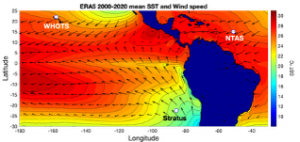
Figure 1: Locations of Ocean Reference Stations.
Data collections continued for special initiatives, including the OceanSITES deep temperature observing initiative to provide data to better constrain and improve the performance of ocean models, and the PIs are working to facilitate use of the ORS time series by modelers and other researchers. Another ongoing effort involves merging the surface meteorological and air-sea flux observations to continuous long time series with well-documented accuracies. These long-time series are essential to assessing the realism of atmospheric models.
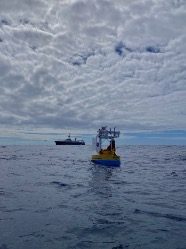
Figure 2: The work at sea to maintain the Stratus ORS continues to use the Chilean Navy vessel AGS 61 Cabo de Hornos chartered from the Armada de Chile.
60-Year Global Ocean Surface Heat Flux Analysis FY24, PI Lisan Yu – WHOI
The Objectively Analyzed air-sea Fluxes (OAFlux) project improves global air-sea flux estimates by employing four key approaches: (1) applying mathematical optimization to reduce biases in datasets sourced from multiple platforms, (2) leveraging machine learning to improve satellite-based retrievals of air temperature and humidity, (3) integrating in situ measurements from more than 150 buoy time series, including OceanSITEs reference stations, for validation, and (4) developing methods to incorporate high-resolution, mobile observations from Saildrones, which provide targeted flux measurements in remote and under-sampled regions. Through these efforts, OAFlux improves the accuracy and reliability of air-sea flux estimates, advancing the understanding of ocean-atmosphere variability and improving prediction capabilities.
OAFlux produces global daily and monthly analyses (1958–present) of ocean evaporation, surface heat fluxes, winds, and air-sea variables. These datasets, updated annually, are freely available at http://oaflux.whoi.edu.
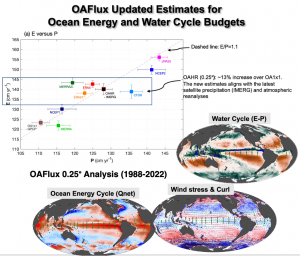
Figure 3: OAFlux Analysis (1988-2022).
Enabling Glider-based Monitoring of pH and CO2 Uptake in the Gulf Stream, PI Robert Todd – WHOI
This project has deployed a fleet of next-generation autonomous underwater gliders with novel pH sensors to estimate surface pCO2, and to demonstrate the ability of these gliders to measure CO2 uptake in the Gulf Stream along the US East Coast and across all seasons.
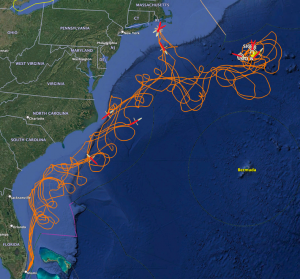
Figure 4: Glider surveys in the Altantic.
Distribution and Prevalence of Harmful Algal Blooms in Arctic Waters, PI Don Anderson – WHOI
Recent observations made possible through funding by the NOAA Arctic Research program have provided irrefutable evidence that harmful algal blooms (HABs) occur in the Alaskan Arctic. Of particular concern are the toxic dinoflagellate Alexandrium catenella, the organism responsible for paralytic shellfish poisoning (PSP), as well as toxic diatoms in the genus Pseudo-nitzschia, which cause amnesic shellfish poisoning (ASP). These species can form of massive blooms covering hundreds of km2, and that the potent toxins they produce may already be impacting marine mammals, seabirds, and thereby threatening the health and food security of subsistence harvesters.
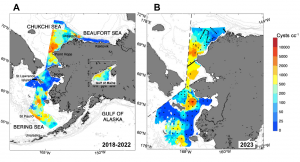
Figure 5: Alexandrium catenella cyst concentrations (0-3 cm) from A) all samples collected during 2018-2022 and B) from 2023 research cruises. Data collected from 2023 B) reveals a new cyst hotspot off Nome, AK.
Field collections during NOAA-funded Distributed Biological Observatory (DBO) cruises in FY18 - FY24 as well as surveys conducted by other programs confirmed that the vegetative cells of these taxa are present in the Chukchi Sea and adjacent waters in most years, and that extraordinarily large concentrations of dormant A. catenella cysts have accumulated in the sediments on the Chukchi shelf, at the entrance to the Beaufort Sea, and in the eastern Bering Sea, representing a massive seedbed that can support recurrent blooms and further species dispersal into the Arctic.
The goal of this ongoing work is to augment the existing datasets with several sets of samples for analysis of Arctic HAB taxa, collected opportunistically by our lab and our collaborators in 2023 and 2024 through ships of opportunity (e.g., DBO research cruises). These datasets are extremely valuable as they will be paired with measurements of algal toxins in birds, marine mammals and fish that are currently being analyzed by collaborators at the NOAA Northwest Fisheries Science Center. Samples to be analyzed during the upcoming year will augment the DBO lines that have been the focus of intensive sampling thus far and therefore fill an important gap in our understanding of the prevalence of HAB populations and toxins in near-shore locations where shellfish and other marine wildlife are harvested.
